Since opening doors in 1998, Penny Farthing Productions has had the honor of working with top talent in the comics and publishing industry. Below are just a few of the legendary artists who we’ve worked with in the past to ensure the art you see in our publications is nothing short of the best.
-
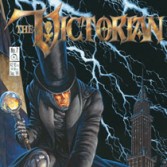
Bernie Wrighston
Read MoreBernie Wrighston

The cover of The Victorian, Issue 7: Disinterment by Bernie Wrightson.
Bernie “Berni” Wrightson (born October 27, 1948, Baltimore, Maryland, U.S.) is an American artist known for his horror illustrations and comic books. He received training in art from reading comics, particularly those of EC, as well as through a correspondence course from the Famous Artists School.
In 1966, Wrightson began working for The Baltimore Sun newspaper as an illustrator. The following year, after meeting artist Frank Frazetta at a comic-book convention in New York City, he was inspired to produce his own stories. In 1968, he showed copies of his sequential art to DC Comics editor Dick Giordano and was given a freelance assignment. Wrightson began spelling his name “Berni” in his professional work to distinguish himself from an Olympic diver named Bernie Wrightson, but later restored the final E to his name.
Swamp Thing #1 panel, original ink art by Berni Wrightson, © DC Comics, Inc.
His first professional comic work appeared in House of Mystery #179 in 1968. He continued to work on a variety of mystery and anthology titles for both DC and its principal rival, Marvel Comics. In 1971, with writer Len Wein, Wrightson co-created the muck creature Swamp Thing for DC. He also co-created Destiny, later to become famous in the work of Neil Gaiman. In 1971 he also published BadTime Stories, a horror/sci-fi comics anthology featuring his own scripts and artwork, each story being drawn in a different medium (ink wash, tonal pencil drawings, duoshade paper, screen tones, e.g., along with traditional pen-and-ink and brushwork).
Wrightson had originally been asked by DC to handle the art for its revival of The Shadow, but he left the project early on when he realized he could not produce the necessary minimum number of pages on time.
By 1974. he had left DC to work at Warren Publishing, for whose black-and-white horror-comics magazines he produced a series of original work as well as short story adaptations. As with BadTime Stories, Wrightson experimented with different media in these black-and-white tales: Edgar Allan Poe’s “The Black Cat” featured intricate pen-and-ink work which stood in direct contrast with his brush-dominated Swamp Thing panels. “Jenifer”, scripted by Bruce Jones, was atmospherically rendered with gray markers. “The Pepper Lake Monster” was a synthesis of brush and pen-and-ink, whereas H.P. Lovecraft’s “Cool Air” was a foray into duotone paper. “Nightfall” was an exercise in ink wash and a subtle “Little Nemo in Slumberland” satire, and “The Muck Monster” a sequential art precursor to Wrightson’s Frankenstein, with the Franklin Booth-inspired pen-and-ink style in evidence.
In 1975, Wrightson joined with fellow artists Jeff Jones, Michael Kaluta, and Barry Windsor-Smith to form The Studio, a shared loft in Manhattan where the group would pursue creative products outside the constraints of comic book commercialism. Though he continued to produce sequential art, Wrightson at this time began producing artwork for numerous posters, prints, calendars, and even coloring books. He also drew sporadic comics stories and single illustrations for National Lampoon magazine from 1973 – 1983.
Wrightson spent seven years drawing approximately 50 detailed pen-and-ink illustrations to accompany an edition of Mary Shelley’s novel Frankenstein, which the artist considers among his most personal work.
Wrightson illustrated the comic book adaptation of the film Stephen King-penned horror film Creepshow,. This led to several other collaborations with King, including illustrations for the novella “Cycle of the Werewolf”, the restored edition of King’s apocalyptic horror epic, The Stand, and Wolves of the Calla, the fifth installment of King’s Dark Tower series.
Wrightson has contributed album covers for a number of bands, including Meat Loaf.
The “Captain Sternn” segment of the animated film Heavy Metal is based on a character created by Wrightson.
He did production design for the characters the Reavers in the 2005 film Serenity.[1]
-
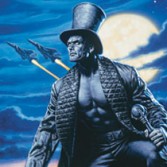
Bob Larkin
Read MoreBob Larkin

The cover of The Victorian, Act I: Self-Realization graphic novel by Bob Larkin.
Bob Larkin (born July 10, 1949) is an American artist primarily known for his painted covers for Marvel Comics’ magazine-format titles, published under the imprints of Curtis Magazines and Marvel Magazines in the 1970s and early 1980s.
A prolific and accomplished painter, Larkin’s many credits include titles such as The Savage Sword of Conan, Marvel Super Special, Marvel Preview, The Deadly Hands of Kung-Fu, Planet of the Apes, and Tomb of Dracula. Larkin also painted covers for many of the Marvel Fireside Books paperback collections, lending them a simple, movie-poster feel. He did the same thing for the cover to the first major intercompany crossover, Superman and Spider-Man. In addition, Marvel occasionally tapped Larkin to paint covers for premiere issues of such comic book titles as Dazzler and The Saga of Crystar.
Besides his work for Marvel, Larkin has painted covers for Vampirella and The Rook (Warren Publishing), The Amazing Adventures of Holo-Man (Peter Pan Records), Lorelei: Building the Perfect Beast (StarWarp Concepts), and many others.
Larkin also provided covers to Bantam Books reprints of Doc Savage, and is considered second only to James Bama for his covers.
Larkin’s artwork also adorns World Wrestling Entertainment merchandise featuring The Rock, “Stone Cold” Steve Austin, The Undertaker, Kane, and Chris Jericho.
With wife Fran, Larkin is the father of a son named Ken and two daughters, Claire and Holly.
-
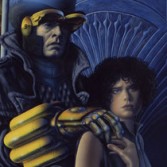
Jim Burns
Read MoreJim Burns

The Art Director’s Club of Houston, bronze medal winning cover of The Victorian, Act IV: Self-Overcoming by Jim Burns.
Jim Burns (born April 1948) is a Welsh artist born in Cardiff, Wales.
In 1966 he joined the Royal Air Force, but soon thereafter he left and signed up at the Newport School of Art for a year’s foundation course.
After that, he went on to complete a 3-year Diploma in Art and Design at St. Martin’s School of Art in London. When he left St. Martin’s in 1972 he had already joined the recently established illustration agency Young Artists. He has been with this agency, later renamed Arena, ever since.
He is today a contemporary British science fiction illustrator. His work mostly deals with science fiction with erotic overtones. His paintings are generally intricate photo-realistic works of beautiful women set against advanced machines and spaceships. While his preparatory sketches are more erotically focused, his final works and published book covers have a more academic tone portraying far off and imaginary worlds.[citation needed]
Apart from book and game covers, Burns briefly worked with Ridley Scott on Blade Runner. He has also had books of his own works published, including Lightship, Planet Story (written by Harry Harrison), Mechanismo, Transluminal, and Imago.
Burns won the Hugo award for best professional artist three times—the only non-American ever to have won it—and has also been awarded 12 BSFA awards. Well regarded in fandom, he was artist guest of honour at the 1987 Worldcon.
-
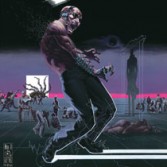
Jim Steranko
Read MoreJim Steranko

James Steranko (born 5 November, 1938,[1] Reading, Pennsylvania, United States) is an American graphic artist, comic book writer-artist-historian, magician, publisher and film production illustrator. His most famous comic-book work was with the 1960s superspy feature “Nick Fury, Agent of S.H.I.E.L.D.” in Marvel Comics’ Strange Tales and in the subsequent eponymous series. Steranko earned lasting acclaim for his innovations in sequential art during the Silver Age of comic books, particularly his infusion of surrealism, op art, and graphic design into the medium. His work has been published in many countries and his influence on the field has remained strong since his comics heyday.
He was inducted into the Will Eisner Comic Book Hall of Fame in 2006.
Jim Steranko came out of retirement to paint the cover of the very first issue of The Victorian: Tours of the Blue Clock, which later won the Spectrum Award.
-
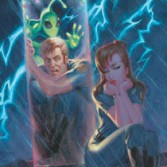
Joe Chiodo
Read MoreJoe Chiodo

Joe Chiodo’s unique style is showcased in the cover artwork of the entire Decoy: Storm of a Century series.
Joe Chiodo is a colorist who has worked in the comics industry. He has been recognized for his work with a nomination for the Comics Buyer’s Guide Favorite Colorist Award in 1997 (with the company Wildstorm FX and colleague Jessica Ruffner), and in 1998 under his own name.[1] Chiodo was born on January 22, 1958, the youngest of four boys and raised in San Jose, California. He traveled to various places such as New York and Los Angeles, where he worked for a diverse client base, doing book covers, and other work for toy companies, games, and comics, eventually settling in San Diego.
Chiodo has been recognized as an award-winning pin-up artist and illustrator.[citation needed] He combines cartoony techniques with those of classic pin-up artists, often working on a range of body types and pulp themes. He illustrated the children’s alphabet board book The Adventures of WonderBaby, and wrote a book, How To Draw And Paint Pin-Ups.
Chiodo currently works out of his home which he shares with his wife and two children.
-
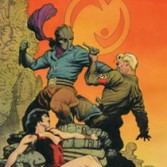
Mark Schultz
Read MoreMark Schultz

Mark Schultz (born 1955) is an American writer and illustrator of books and comics. His most widely-recognized work is his self-created and owned comic book series, Xenozoic Tales, about a post-apocalyptic world where dinosaurs and other prehistoric creatures coexist with humans. He is also the current writer of the Prince Valiant comic strip.
The cover of Captain Gravity: Original Series Graphic Novel by Bob Schultz.
-
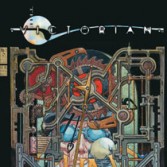
Michael Kaluta
Read MoreMichael Kaluta

Michael Kaluta has won several Spectrum awards for cover art that he did for The Victorian.
Born in Guatemala to U.S. citizens, Kaluta studied at the Richmond Professional Institute (now Virginia Commonwealth University).
His early work included a Flash Gordon story for Charlton Comics and an adaptation of Edgar Rice Burroughs’s Venus novels for DC. Kaluta’s influences and style is drawn more from pulp illustrations of the 1930s – his signature motif is elaborate decorative panel designs – rather than the silver age comics of the 1960s. Kaluta has worked rarely with the superhero genre. Associated during that period with Bernie Wrightson and Jeff Jones he also contributed illustrations to Ted White’s Fantastic. He is known for his work on the series Starstruck and The Shadow. He co-created Eve, the horror host turned The Sandman supporting character.
Because Kaluta’s art is so meticulous and time-consuming, his style is not well suited for ongoing comic book work, which generally requires twenty or more pages completed by an artist each month. As a result, when he does accept comic assignments, Kaluta prefers it to be limited series, one-shots, or simply cover illustrations.
He was one of the four comic book artists/fine illustrator/painters who formed the artists’ commune The Studio in a loft in Manhattan’s Chelsea district from 1975 to 1979. His Studio colleagues were Barry Windsor-Smith, Jeff Jones, and Bernie Wrightson.
Aside from many comic books and covers he has done a wide variety of book illustrations. Among music fans, Kaluta is known as the artist for the cover of Glenn Danzig’s instrumental album Black Aria and for the interior illustration of Danzig’s fourth album, the latter of which appeared in 1994-95 as a pendant sold at Danzig concerts, and on Danzig T-shirts and sweaters produced in the same period. Kaluta has also done artwork for role-playing game companies such as White Wolf and Wizards of the Coast.
His work has won him a good deal of recognition, including the Shazam Award for Outstanding New Talent in 1971 and the 2003 Spectrum Grandmaster Award.
In the early 1990s, he was active in Compuserve’s Macintosh Gaming Forum, in the flight simulator enthusiast group which called itself VFA-13 Shadow Riders. He contributed a number of designs for airplane nose art and flight suit unit patches.
-
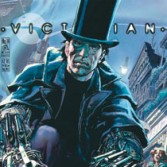
Neal Adams
Read MoreNeal Adams

Neal Adams (born June 12, 1941, Governors Island, Manhattan, New York City) is an American comic book and commercial artist best known for helping to create some of the definitive modern imagery of the DC Comics characters Superman, Batman, and Green Arrow; as the co-founder of the graphic design studio Continuity Associates; and as a creators-rights advocate who helped secure a pension and recognition for Superman creators Jerry Siegel and Joe Shuster.
The cover of The Victorian, Issue 14: A Question of Questions by Neal Adams.
-
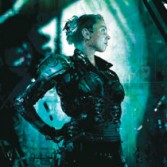
Stephan Martinière
Read MoreStephan Martinière

Stephan Martinière’s distinctive artwork is showcased in the cover art throughout the PARA series, of which Issue 2 won a Spectrum Award.
Stephan Martinière is an artist, cartoonist, concept illustrator, and animation director working primarily in the science fiction and fantasy fields. He attended high school at a school in Paris. He won the Hugo Award for Best Professional Artist in 2008 and was previously nominated in 2006 and 2007.
As an illustrator and animation director, Stephan has won numerous Awards including: – The Grand Master Award from Ballistic Media’s Expose 4, – four Master Awards and nine Excellence Expose Awards from Ballistic Media, – The British Science Fiction Association Award for Best Cover of 2004, – The Chesley Award for best hard cover of 2006, – Two Silver Award for Editorial in 1997 and 2008 and a Gold Award in 2004 from Spectrum, A Thea Award for his work on the Paramount theme park Super Saturator in 2001.
As a director for the animated special “Madeline,” Stephan won the Humanitas Award, the A.C.T Award and the Parent’s Choice Award and was nominated for an Emmy Award.
-
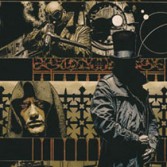
Tim Bradstreet
Read MoreTim Bradstreet

The Spectrum award winning cover of The Victorian, Act 1: Sourcebook by Tim Bradstreet.
Bradstreet has been working professionally ever since he graduated high school in 1985. He is primarily self-taught, choosing – instead of institutional training – to begin shaping his talent under the tutelage of fellow illustrator Steve Venters at Fantasmagraphics. With Venters’ guidance, Bradstreet began illustrating role-playing games, honing his skills while pursuing his long-time ambition to draw comics. In 1990, he got his big break, working with industry legend Tim Truman on Dragon Chiang.
His work on role-playing games continued with GDW’s Twilight 2000 and FASA’s Shadowrun. Bradstreet’s work on White Wolf’s Vampire: The Masquerade garnered him much critical praise. This, in turn, led to the addition of many major comic book publishers to his clientèle. He has since drawn for scores of comic and game related projects including Activision’s Vampire: Bloodlines video game, Dark Horse’s Hard Looks and Another Chance to Get It Right (with author Andrew Vachss), Star Wars, Clive Barker’s Age of Desire, Marvel’s The Punisher and Blade, and Vertigo’s Gangland, Unknown Soldier, Human Target, and Hellblazer.[1] Bradstreet was awarded the 1996 Best Artist award by the International Horror Guild.[2] He was nominated for the 2005 Art award for the International Horror Guild for his Hellblazer covers.[3] Bradstreet has also been nominated for the 2002 Best Cover Artist Eisner Award for his Hellblazer covers.
In 2000, he joined director Guillermo Del Toro as a conceptual artist helping work on the visual design for the film Blade 2. In 2003, Bradstreet worked on a number of movie posters for the Marvel/Lions Gate film, The Punisher and also worked on the black and white stop motion animated scene set in Kuwait for the extended cut DVD.
Bradstreet was also the regular cover artist for two books, Marvel’s The Punisher and Vertigo/DC’s Hellblazer. He has created over 70 covers for both books in the past five years.
In 2006, the British heavy metal band Iron Maiden used Bradstreet’s design for the cover of their album A Matter of Life and Death.
Bradstreet’s style is a distinctive one, once described by him as ‘stylistic photorealism’. His work combines the use of posed photography with pencils, inks and coloring. This method is in keeping with the icons of gritty urban horror that are often the subject of his work. This is not to imply a limited range as Bradstreet has worked on subject matter ranging from high fantasy to science fiction, tied together by little other than his trademark photorealism and a ubiquitous brick wall or two.
Bradstreet and wife Missy live in San Diego, California.
